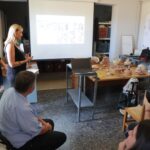

Corinthia: An enticing destination with a unique history for quality holidays
As part of a targeted initiative to highlight and enhance the region’s tourism profile, the Municipality of Nafpaktia, in collaboration with the Ephorate of Antiquities of Aetolia-Acarnania and Lefkada, organized a three-day press familiarization trip from June 27th to 29th. This event took place under the auspices of the official launch of the new tourism campaign, titled “Whatever You’re Looking For Awaits You #here.”
Against the backdrop of Nafpaktia’s unique cultural and natural landscape, representatives from leading media outlets experienced firsthand the region’s limitless possibilities, through a series of authentic experiences interweaving history, culture, nature, and distinctive local gastronomy.

Presentation of the New Tourism Campaign
The familiarization trip began with the official presentation of the Municipality’s new tourism campaign, co-produced with the Ephorate of Antiquities of Aetolia-Acarnania and Lefkada. The event took place in a setting of great symbolic significance—framed by the historic city walls and the tranquil Corinthian Gulf—at the iconic Venetian Port, and was attended by local officials, campaign contributors, and a large audience.
On Psani Beach, the seaside restaurant “Byzantino” serves exquisite Mediterranean cuisine, perfectly complemented by a unique seaside view.

Discovering Nafpaktos
The second day was dedicated to exploring the town of Nafpaktos and its wider area, with a guided tour led by Ms. Aphrodite Tiligada, a representative of the Ephorate of Antiquities of Aetolia-Acarnania and Lefkada.
Noteworthy landmarks include the Venetian Port—a living monument to the town’s history—the recently restored walls of the port’s breakwaters, the historic lighthouse, and the Fethiye Mosque, built by Bayezid II in 1499 on the eastern breakwater and now serving as an exhibition space. Of particular note is the latest solo exhibition by artist Sofia Sidiropoulou, titled “Transmutation,” which is hosted at the Fethiye Mosque from June 1st to July 15th.

Dominating the western breakwater stands the statue of Giorgos Anemogiannis, the legendary fire ship captain who perished heroically in the Greek War of Independence during an attempt to liberate Nafpaktos. Nearby, at the Miguel de Cervantes Cultural Park, the statue of world-renowned Spanish author and warrior Miguel de Cervantes Saavedra stands as a perpetual reminder of the historic Battle of Lepanto (1571), which took place at the western entrance to the Corinthian Gulf and shaped the course of European history.
The imposing Castle of Nafpaktos—one of Greece’s best-preserved castles—offers panoramic views over the Corinthian Gulf and narrates the site’s rich history. Equally remarkable is the Byzantine Museum of Aetolia-Acarnania, housed within the castle walls and shedding light on the region’s Byzantine and post-Byzantine heritage.

Next to the castle’s ancient walls, the experienced Lepanto Archery team introduces visitors to the art of archery, offering a unique experience that connects with both historical tradition and sport.
A short boat ride from Nafpaktos harbor lies the enchanting islet of Trizonia—the only inhabited island in the Corinthian Gulf. Amid a landscape of stunning beauty, the traditional seafood taverna “OSTRIA” offers fresh fish and seafood with views across the sapphire waters.
In the district of Lygia, also known as Niokastro, just 3.5 kilometers from Nafpaktos, the taverna “I Parea” (Bebis) serves up unique rural Greek flavors—including spit-roasted lamb, kokoretsi, kontosouvli, and a variety of grilled meats—each lovingly prepared by the owner Dimitris Dimitropoulos, affectionately known as “Bebis.”
Paths of Culture and Nature
The final day began with a guided tour by Ms. Efi Saranti, Head of the Ephorate of Antiquities of Aetolia-Acarnania and Lefkada, of the impressive Ancient Theatre of Makynia—one of the area’s most significant ancient monuments, revealing the region’s continuous cultural narrative from antiquity to the present. The ruins of ancient Makynia lie at “Paliokastro” in the Municipality of Antirrio, in a strategic location that afforded control over both land and sea. The ancient theatre, situated southeast of the acropolis and excavated since 1988, is believed to have originally served as a bouleuterion (council chamber).
Just outside Nafpaktos, at Aidoni Gavrolimnis on an expanse of 100 acres, Mr. Aristotelis Zelios has established the “Zelios Gi” Botanical Garden—a haven dedicated to environmental education, biodiversity, and the rich flora of Nafpaktia. This green oasis offers a sanctuary of tranquility and learning, featuring 3,500 aromatic, medicinal, and culinary herbs, including both common and rare Greek species, as well as a selection of vegetables. Each plant is accompanied by its own story, giving the garden a distinctly educational character. Additionally, hands-on workshops in pottery and the casting of aluminum objects by skilled artisans reveal the secrets of these crafts.

In the seaside village of Kryoneri, east of Nafpaktos, the “Captain del mare” fish taverna is an ideal destination for those in search of genuine gastronomic pleasures right beside the waves, with a view to the imposing Varasova rock.


The final stop: “Kasteli of Roumeli”. The Castle of Antirrio stands at the southernmost tip of Aetolia-Acarnania, beneath the modern Rio–Antirrio Bridge and beside the harbor where ferries once connected the Peloponnese to Western Greece.


















